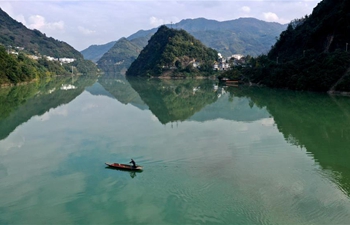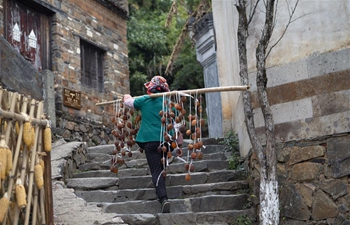ADEN, Yemen, Nov. 10 (Xinhua) -- Yemen is facing a serious humanitarian catastrophe created by the large fields of landmines and explosive remnants that haunt several provinces of the impoverished Arab country.
The ongoing fighting between Yemen's government and the Iran-backed Houthi rebels remains the major reason of the dramatic increase of landmines fields.
Yemen's internationally-backed government repeatedly blames the Houthi rebels for planting thousands of landmines in many areas of the country in an attempt to impede the progress of the armed forces against the Houthi-held sites.
"In 2014 Yemen was on the verge of completing the last phase of demining the low-impact areas, which are far from the population," said Ameen Saleh Oqaili, head of the Yemeni national demining program.
"What happened next was a real humanitarian catastrophe," Oqaili, who worked previously as an explosives expert, told Xinhua, as the Houthi armed group invaded the capital Sanaa militarily in late 2014, controlled most of Yemen's northern provinces and then advanced toward the southern provinces.
"Mines were planted at a very high intensity in all the areas seized by the Houthi group," he said.
"Large areas of Yemen are now classified as high-impact areas. Mines have been planted in urban and rural areas, schools and roads," he added.
The most mine-affected areas are the west coast areas on the Red Sea, the provinces of Taiz, Aden, Abyan, Al-Jawf, Marib, Shabwa, Hajjah, and the southern province of Dhalea, according to the National Demining Program.
The Houthi rebels plant the mines in both organized and random ways, a program statement said.
Initial estimations indicate that the Houthi rebels had planted more than 1 million mines, among which 500,000 have been cleared to date.
Oqaili said the mines laid by the Houthis include a variety of anti-vehicle and anti-personnel mines.
"The Houthis have also heavily planted explosive devices that were modified from mines and are operating with remote controls, by electric circuits or by infrared rays," he noted.
On a daily basis, civilian casualties occur in several areas of Yemen as a result of Houthi-laid landmines.
Oqaili confirmed that more than 6,000 civilian casualties were recorded, including women and children.
The Yemeni official pointed out that there are great difficulties facing the program, including the inability to reach all areas because of the continued conflict.
"The innovative mines that were developed and modified by Houthis require us to develop the skills of those working in the program of dismantling mines," the Yemeni official said.
The Houthis used to plant camouflaged mines in various forms, such as the form of stones, which are difficult to identify.
The Houthi fighters previously planted thousands of landmines and improvised explosive devices (IEDs) before their withdrawal from different areas located along the country's western coast, according to Yemeni government officials.
The landmines and IEDs continue posing a threat to the civilians despite the ongoing efforts exerted by the experts of the mine-clearing project in Yemen.
Previous reports by humanitarian organizations said Yemen has become one of the largest landmine battlefields in the world since World War II.

















